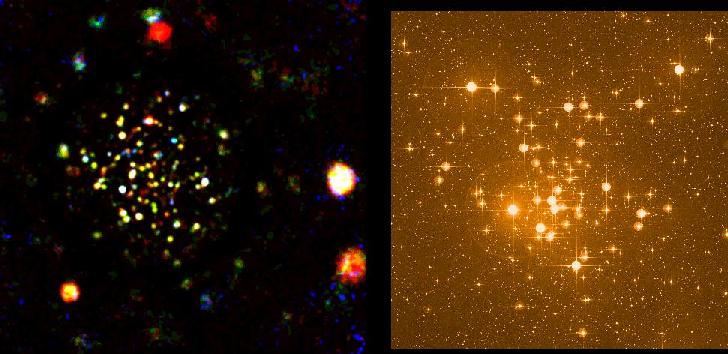
 Credit: Thomas Preibisch
Credit: Thomas Preibisch
X-ray Colors of Young Stars
The image on the left is a "true colour" X-ray image of the distant
(d = 1300 light years) young stellar cluster NGC2516 in the Carinae
nebula, produced from the archive data of a 77000 sec (more than 21
hours!) observation obtained with the ROSAT Position
Sensitive Proportional Counter. The field of view is about 40 times 40
arcmin. X-ray emission in these young stars is produced as the outer
stellar atmosphere is heated by intense magnetic activity generated by the
stellar "dynamo" of these quickly rotating stars. The X-ray colors
reflect the temperature of the X-ray emitting gas: red is relatively cool
(only a million degrees!) while blue-white represents gas at much higher
temperatures (near 10 million degrees). Note that, away from the center
of the X-ray image, the apparent "size" of the sources increases (i.e. the
sources appear "larger"); this is actually an instrumental effect produced
by the de-focussing of off-axis X-rays by the ROSAT mirrors. The image on
the right is an optical image of this cluster (about the same field of
view). NGC 2516 was discovered by Abbe Nicholas Louis de la Caille in 1751
during during his 2-year journey to the Cape of Good Hope.
Last Week *
HEA Dictionary * Archive
* Search HEAPOW
* Education
Each week the HEASARC
brings you new, exciting and beautiful images from X-ray and Gamma ray
astronomy. Check back each week and be sure to check out the HEAPOW archive!
Page Author: Dr. Michael F.
Corcoran
Last modified November 2, 1999


